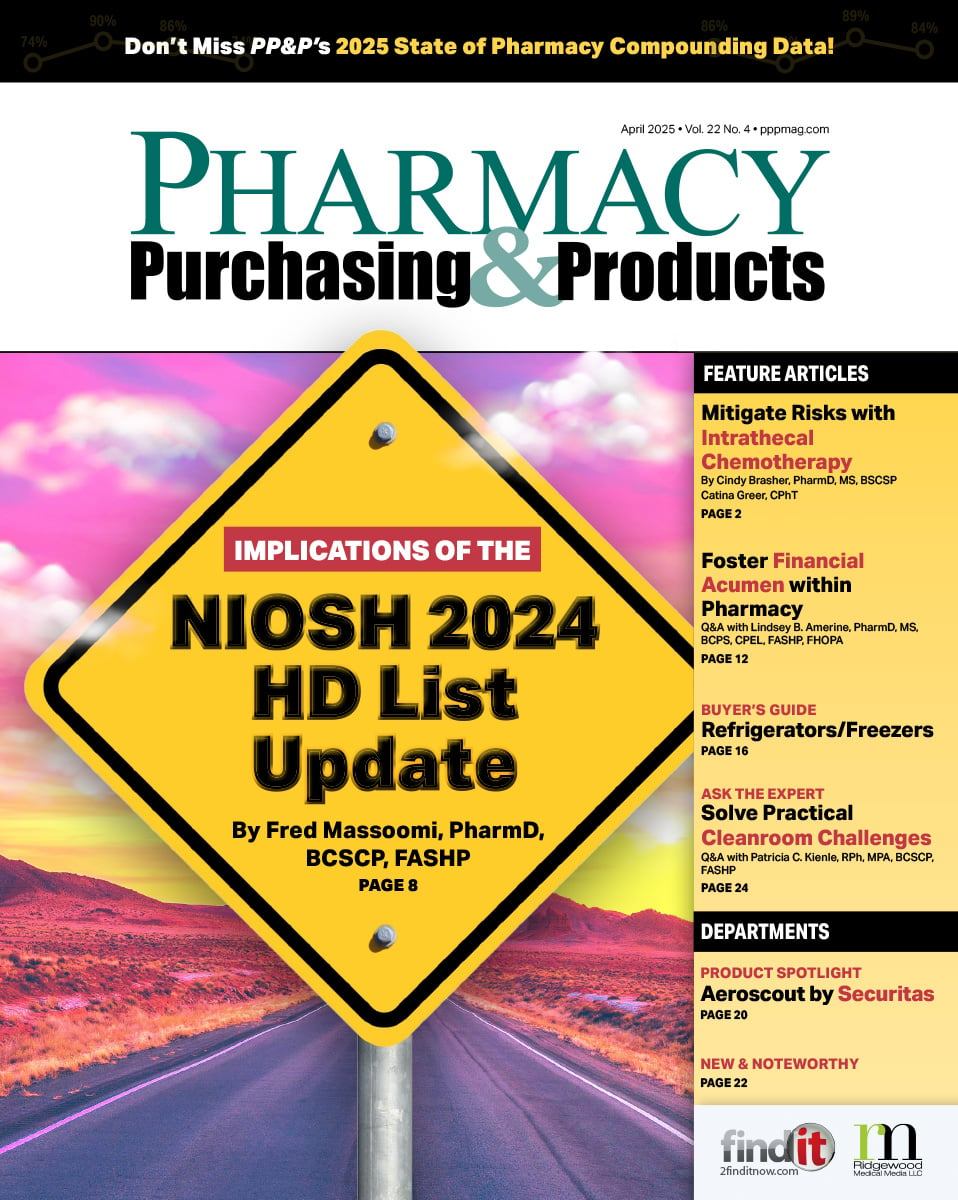- Show Menu
- Contact Us
- FAQs
- Reader Service
- Survey Data
- Survey Winners
- Testimonials
- Upcoming Events
- Webinars
- White Papers
Site Visits to Evaluate Outsourced Compounders
Q&A with Caryn Belisle, BS Pharm, RPh, MBA, and Keely Kwok, BS, CPhT
Brigham and Women’s Hospital
Boston, Massachusetts
Pharmacy Purchasing & Products: What is the goal of conducting a site visit to an outsourced compounder?
Caryn Belisle, BS Pharm, RPh, MBA, and Keely Kwok, BS, CPhT: The Brigham and Women’s Hospital Pharmacy Department has been performing compounding vendor site visit audits for well over a decade; in recent years, this process has expanded to include visits to other hospitals within the Partners Healthcare System to assess their needs. The purpose of the visits to outsourced compounders is to assess the overall quality and operations of the facilities. We accomplish this by performing a physical tour, observing live compounding, and meeting with the managers responsible for the facility’s operations and quality programs.
PP&P: In what circumstances does your hospital outsource compounded sterile preparations?
Belisle and Kwok: Current USP regulations make it challenging for many hospital pharmacies to perform anticipatory compounding. Further, there is a direct correlation between decreased beyond-use dates for sterile products and an increase in the labor and waste associated with the compounding of those products. Therefore, we outsource high usage, standard admixtures, especially those that are stored at room temperature, through 503B outsourcing facilities. These admixtures include controlled substances (eg, PCAs and epidurals), vasopressors (norepinephrine, vasopressin), anesthetics (buffered lidocaine), and oxytocin infusions. We also outsource through 503A compounding pharmacies, as we do not have the capacity or equipment to support the compounding of patient-specific intrathecal pumps for pain management, or for patient-specific total parenteral nutrition admixtures. We utilize the services of two 503A pharmacies and eight 503B outsourcing facilities.
There is currently no single 503B facility that can support all the sterile compounded admixtures our facilities require. This is due to a combination of not necessarily having all of the specific admixtures we use on formulary or being challenged to meet our demand. These, and other concerns keep us from decreasing the number of outsourcer relationships.
One way we are working to overcome these challenges is by initiating an exclusive relationship with a single 503B outsourcer that would provide admixtures to our entire health system. Our goal is to work with all our hospitals to standardize their various admixtures and then have one outsourcing vendor supply these products.
PP&P: What are some considerations for choosing outsourced compounders?
Belisle and Kwok: We chose our exclusive 503B vendor based upon their commitment to quality, cGMP manufacturing expertise, and a vertically integrated supply chain. Other vendors were selected and maintained based on overall quality, meeting our admixture needs, and their historical customer service commitment.
More specifically, if we plan to outsource a new admixture, and two of our current vendors have it on formulary, we will choose the vendor that has had the least number of supply interruptions. If none of our current vendors supply it, we do a search to see if there are any 503B facilities that have it on formulary. If so, we initiate contact and schedule a visit to perform a quality audit prior to purchasing that product.
PP&P: How do you prepare to conduct a site visit to an outsourced compounder?
Belisle and Kwok: Prior to a site visit, we ask the vendor to complete an audit survey form. This comprehensive document includes information regarding licensing, accreditation, inspections, any complaints by a state or federal agency (and any disciplinary actions due to adverse change in status), facility size and capabilities, and any customer complaints. This request is sent in advance to allow time for the vendor to prepare the appropriate documentation for us to review at the time of the site visit.
We also provide a proposed agenda prior to our visit, which includes the following:
- Introduction
- Facility tour and cleanroom compounding observation
- New items (personnel, equipment, facility upgrades, etc)
- FDA Warning Letter Remediation(s) and Corrective Action(s) status
- Documentation review
- Personnel review
- Cleaning and disinfection review
- Validation of equipment and processes
- Low/medium/high risk product processing
- Testing and monitoring
- Diversion monitoring
- Approved vendors
- Calibration/metrology
- Corrective and Preventive Actions (CAPA) review and trending
- Raw Materials Approval program
- Close-out and summary
In addition to the items on the agenda, we observe the facility, the staff at work, and the cleanliness of the cleanrooms and production areas. We typically walk through the production areas, starting with the warehouse where supplies and materials are received, then on to raw materials testing (if applicable), order receipt and staging, compounding in the cleanrooms, QA testing and final product release, and order picking and packaging for shipment.
PP&P: What training documentation, policies and procedures, and environmental monitoring results do you review?
Belisle and Kwok: At least one pharmacist and one pharmacy technician training record are reviewed. In addition, we ask for accompanying policies and procedures pertaining to staff training and competencies, and evaluate if the training outlined in their SOPs aligns with the information that is included in the staff training records. We expect to see routine gloved fingertip sampling, gowning assessment, and media fill testing. We request the most recent month’s environmental monitoring data and any trending data, and also review accompanying environmental and personnel monitoring results.
Occasional out-of-specification environmental monitoring results may occur. In the event of an out-of-specification result, it is critical that appropriate follow-up measures are taken and that the associated CAPA (corrective and preventative action) is reviewed. In general, we expect all environmental monitoring results to fall within specification, especially in the ISO class 5 areas.
PP&P: What constitutes a red flag on a site visit?
Belisle and Kwok: Organizational preparedness is key to a successful site visit. Therefore, the inability to provide requested documentation prior to our visit would cause initial concern. Because there is an abundance of material to evaluate, we expect the vendor to review our proposed agenda prior to our visit and take the necessary actions to prepare for our documentation requests. We also expect subject matter experts to be available at the time of the visit to answer questions.
During the walk-through, close attention is paid to gowning and garbing processes, aseptic technique during compounding, and general staff activity in the cleanroom. We anticipate a segregation of processes throughout the lifecycle of the product, and we seek to verify that these individual areas are neat, clean, and organized.
One or two negative observations might not constitute a red flag; however, if multiple observations are identified in combination with poor documentation, and/or a lack of subject matter experts, this would make us pause and assess if we should start or continue doing business with the vendor.
PP&P: What is the process for utilizing tracer methodology?
Belisle and Kwok: A tracer methodology is used during all site visits. For our existing vendors, we select the product with the highest volume purchase history and request batch records and associated data. We review the entire process: raw materials selection, compounding, and final product testing and release. It is critical that batch records are complete and accurate. Finally, we walk through the facility again, seeking to view new processes and equipment, and address any observations from the previous site visit.
When evaluating a new vendor, there are usually specific products of interest to investigate, and during our facility walk-through, we request batch records for such a product(s) of interest to review.
PP&P: What typically occurs after a site visit?
Belisle and Kwok: Immediately following the visit, we schedule an internal meeting with all the attendees to go over notes, observations, and to discuss our general thoughts about the facility, the processes, and the people. The hospital quality assurance coordinator then circulates a draft report that includes the following:
- Executive Summary
- Overview
- Findings
- In-Compliance
- Summary
The findings section comprises two subsections: observations and best-practice recommendations. Observations are critically important, so in the event of an issue, we require a formal, written plan of correction from the vendor within 30 days of receipt of the report. Best-practice recommendations are advisory only, and do not require a response. The in-compliance section of the report provides an opportunity to state positive feedback and outline some of the best practices that we observed during our site visit.
PP&P: After contracting with a vendor, when should you consider revisiting vendors?
Belisle and Kwok: 503A and 503B vendors are revisited every 3 years, or sooner if there is a newly opened facility or concerns regarding quality or customer service. We rotate our visits every 3 years for a single vendor if there are multiple locations across the country from which we receive products.
 Caryn Belisle, BS Pharm, RPh, MBA, is the director of pharmacy regulatory compliance, quality, and safety at Brigham and Women’s Hospital (BWH) in Boston. She has served as president of the Massachusetts Society of Health-System Pharmacists and presently serves on the House of Delegates for the American Society of Health-System Pharmacists.
Caryn Belisle, BS Pharm, RPh, MBA, is the director of pharmacy regulatory compliance, quality, and safety at Brigham and Women’s Hospital (BWH) in Boston. She has served as president of the Massachusetts Society of Health-System Pharmacists and presently serves on the House of Delegates for the American Society of Health-System Pharmacists.
Keely Kwok, BS, CPhT, is the quality assurance coordinator for the pharmacy department at BWH. She received her BS in both microbiology and food science and technology at the University of Massachusetts in Amherst. Classically trained in microbiology, she has experience in both academic research laboratory and cGMP laboratory settings. Keely later obtained her pharmacy technician licensure and certification after starting her career at BWH pharmacy.
Like what you've read? Please log in or create a free account to enjoy more of what www.pppmag.com has to offer.








